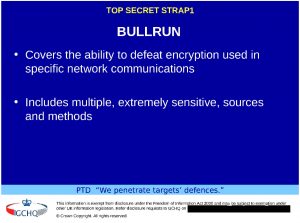Purpose:
BULLRUN is an NSA programme aimed at decrypting encrypted network traffic [GUA01]. Decryption capabilities include inserting vulnerabilities into commercial encryption tools and IT systems, collaboration with other intelligence agencies, and “advanced mathematical techniques” [NYT01, GUA02]. The programme has the ability to decrypt data flowing through major communications provides and peer-to-peer tools such as Skype [NYT02].
Encryption keys are harvested from servers and held in a Key Provisioning Service, which can automatically decrypt traffic if a key is available, or otherwise ask a Key Recovery Service to obtain the key [NYT02].
The programme also seeks to “influence policies, standards and specifications for commercial public key technologies” [NYT02]. The NSA is believed to have inserted a cryptographic backdoor into a standard published by the National Institute of Standards and Technology (NIST) and the International Organization for Standardization (ISO), and to have paid a U.S. software company to implement the flawed standard [REU01].
GCHQ has a similar programme named EDGEHILL [GUA01]. GCHQ has been working to develop methods to decrypt the traffic of Hotmail, Google, Yahoo and Facebook, and proposed a system to decrypt data from fibre-optic cable tapping programmes such as TEMPORA in “near-real time” [GUA01].
Capabilities:
- Decryption of:
- Transport Layer Security/Secure Sockets Layer (TLS/SSL)
- Encrypted web traffic (HTTPS)
- Secure Shell (SSH)
- Virtual Private Networks (VPNs)
- Voice over Internet Protocol (VoIP)
- 4G mobile networks
Exploitation of:
- Service provider internal networks and cloud storage
- Commercial encryption software
- Standards for encryption systems
Data extraction sources:
- Fibre-optic cables
- Commercial encryption software
- Web services (e.g. Hotmail)
Combined with other state surveillance tools:
TEMPORA – fibre-optic cable tapping
Layers of operation:
Background:
The BULLRUN programme partners with technology companies to insert vulnerabilities, and also uses covert activities to manipulate the development of international encryption standards [GUA01]. However, some companies state that they were coerced into handing over their master encryption keys or creating security holes [NYT01].
The programme can be compared with the Clipper Chip proposal of the 1990s, which aimed to mandate weakened encryption in order to facilitate surveillance [NYT02]. The EFF, U.S. congress and others thwarted that earlier proposal, arguing that it was against the 4th amendment of the U.S. constitution.
Company partners:
- Unnamed commercial software companies
- RSA encryption [REU01]
- Standards organisations
Sources:
Electronic Frontier Foundation (EFF)
1) https://www.eff.org/document/20141228-spiegel-gchq-presentation-bullrun-programs-decryption-capabilities
Electrospaces (ELE)
1) http://electrospaces.blogspot.co.uk/search?q=bullrun
Guardian (GUA)
1) http://www.theguardian.com/world/2013/sep/05/nsa-gchq-encryption-codes-security
2) http://www.theguardian.com/world/interactive/2013/sep/05/nsa-project-bullrun-classification-guide
New York Times (NYT)
1) http://www.nytimes.com/interactive/2013/09/05/us/documents-reveal-nsa-campaign-against-encryption.html
2) http://www.nytimes.com/2013/09/06/us/nsa-foils-much-internet-encryption.html
Reuters (REU)
1) http://www.reuters.com/article/2013/12/20/us-usa-security-rsa-idUSBRE9BJ1C220131220

